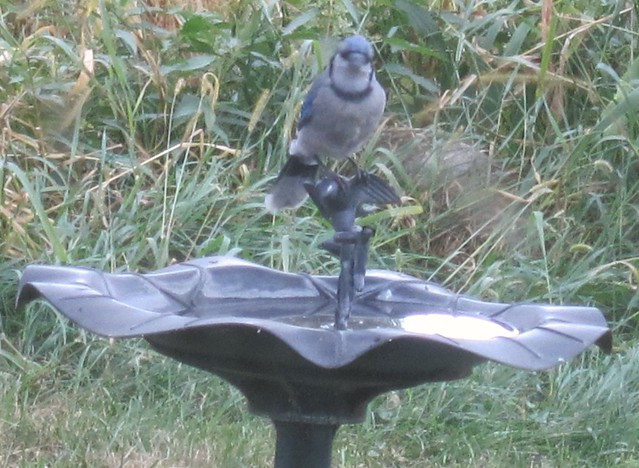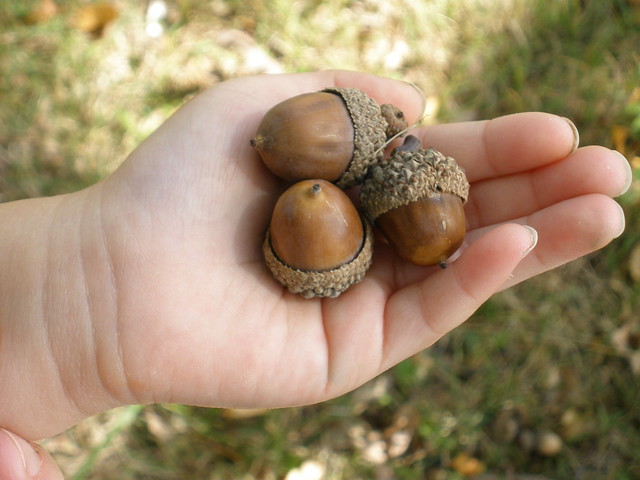Two years ago, we studied blue jays and blue birds. We're starting out our nature studies for the 2014-15 homeschool year with this familiar bird again.
Then each of the girls listened to facts that I had found on All About Birds about blue jays - a familiar bird here at the farm that has blue, white, and black plumage, a pretty crest, and noisy calls.
Blue jay on our bird bath.
There were many interesting things we learned about blue jays from All About Birds. For example:
=> Their fondness for acorns is credited with helping spread oak trees after the last glacial period.
=> Some blue jays migrate while others stay in their range. Others will alternate years that they migrate (migrating one year, not migrating the next).
=> Blue jays are known to take and eat eggs and nestlings of other birds. However, most of their diet was composed of insects and nuts.
=> Blue jays lower their crests when they are feeding peacefully with family and flock members or tending to nestlings.
=> The pigment in Blue Jay feathers is melanin, which is brown. The blue color is caused by scattering light through modified cells on the surface of the feather barbs.
=> Blue jays are found in all kinds of forests but especially near oak trees; and they’re more abundant near forest edges than in deep forest. (This probably explains why they like our farm since we have many mature oak trees.)
Sophia's nature journal entry.
Size wise, blue jays are about 9.8–11.8 inches. Their wingspan is 13.4-16.9 inches. They weigh 2.5-3.5 ounces. As a comparison, nine pennies equals approximately 2.5 ounces.
In terms of eggs, a female will have between 2-7 in her clutch; and will have a single brood each spring. The blue or light brown with brownish spotted eggs are about 1- 1/3 inches in length and .7-.9 inches in width.
The incubation period is 17–18 days and the nesting period is about the same (17-21 days).
Olivia's nature journal entry.
Blue jays carry food in their throat and upper esophagus—an area called a “gular pouch.” They may store 2-3 acorns in the pouch, another one in their mouth, and one more in the tip of the bill. In this way they can carry off five acorns at a time to store for later feeding. Six birds with radio transmitters each cached 3,000-5,000 acorns one autumn. That's an amazingly large number of acorns!
Sophia holding some acorns back in October 2008.
We found a few acorns when we outside, but it will be another month
until the majority of the acorns fall off the trees.
Once Sophia and Olivia worked in their nature journals, we headed outside. It was a nice day after a string of rainy days. While we were listening for blue jays, I had Sophia and Olivia go on a "micro-hike" in which they each had a four-foot piece of yarn that was put on different sections of the grass.
The goal was to explore - at a micro level - the activity that can often be overlooked. Despite being in the same part of the yard, each section had very different items.
Some of the things that Sophia noticed were various groupings of mushrooms and different types of grasses and weeds.
Some of the things that Olivia noticed were: grass, clever leaves, dead grass, dirt, bark, bugs, dead pine needles, "c-shaped thingies," and weeds.
While the girls were observing life at the ground level, I looked around and observed life at the ground to two-foot level.
There was a sunflower that was near the birdfeeder. One of the seeds must have fallen to the ground and germinated.
The hydrangeas are green. They were white back in July, so it looks like before long they will be in their dried state. I leave these up during the winter because they provide a nice landing and sitting spot for the birds.
We've been having lots of problems with moles this year in the back and front yards. This is one of many holes that are in our yard - along with a lot of tunnels.
These little wildlflowers grow each year.
The Black-eyed Susans were adding color to the landscape.
The pear tree even has some pears this years despite an odd spring that went from a first snowy week in May to almost 80 degrees a few weeks later. A severe rainstorm knocked down a lot of blooms so I wasn't sure we'd even get any fruit. This year the fruit seems a bit mis-shapen and damaged. Yet, the flavor is delicious...though the fruit is still on the crisp side.
We collected some things that caught our eyes - such as a feather:
a pretty leaf that's already changing its color:
and a milkweed pod with seeds so tightly packed in the pod still - overlapping one another in a beautiful pattern.
Pretty soon the seeds in other pods will be ready to burst open their homes and set forth on journeys throughout the pastures and yards.
We made our way to the west pasture, and the girls noticed the tremendous number of box elder bugs this year. If you walk past them and don't disturb them, it's not that bad. However, if you get too near and disturb them, Sophia said that they'll all fly up. Clearly, we didn't want that to happen. We avoided them.
As we entered the pasture, the horses noticed us and started to walk towards us.
There are milkweed plants all over the pasture - something that wasn't present when we moved here back in 1995. It's nice to see that our efforts to spreading the seeds throughout our farm are paying off. Hopefully the monarchs are finding enough to eat here.
The goldenrod is in full bloom. The monarchs - on their migration south - visit the goldenrod as do the bees for nourishment.
We spent some time under the oak tree in the west pasture looking for acorns. It's still a bit too early, but we found five - the same amount that a blue jay can hold in its throat and beak.
We enjoyed watching Bailey and Hoss gallop through the pasture.
Hoss was showing off - rolling in dirt like a dog, running at top speed and kicking up his legs; while Bailey walked along with us. Before long, she couldn't resist: she had to run with Hoss. She sped through the pasture - also kicking her legs up and having a great time. She put on quite a show.
The only bird we saw while we were out in the pasture was a large raptor.
When we heard another shrill call we looked up. We're not sure exactly what type it was - maybe a falcon or a hawk. At any rate, it soared in the air directly above us showing its impressive wingspan.
That was, ironically, the only bird we saw the entire time that we were outdoors.
I printed page 38 of Cornell's Classroom Feeder Watch coloring book that had an image of a blue jay and some questions. The girls worked on these after they they had completed their nature journal page and we spent some time outdoors.

























2 comments:
Gorgeous photos Ann!
There are so many things to enjoy about your entry...it was like taking a tour of your place with so much to be interested in. Love the milkweed seeds and the horses running. Thanks for sharing your entry with the OHC Carnival.
Post a Comment